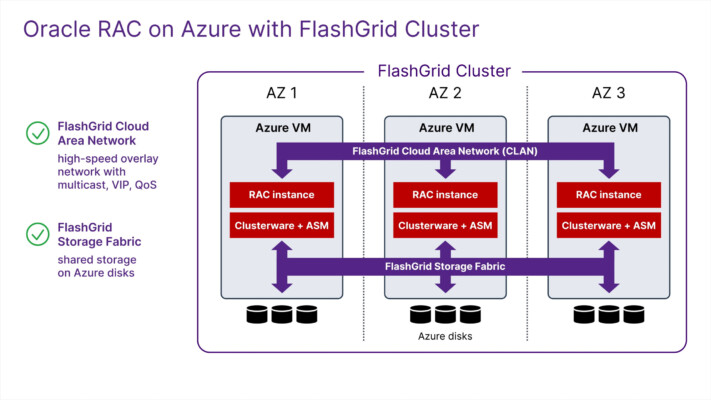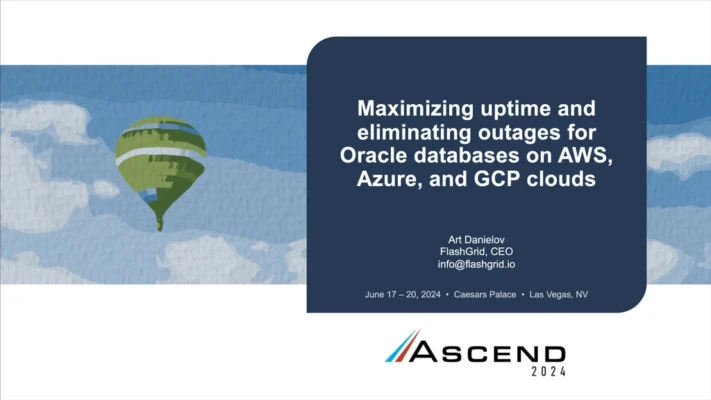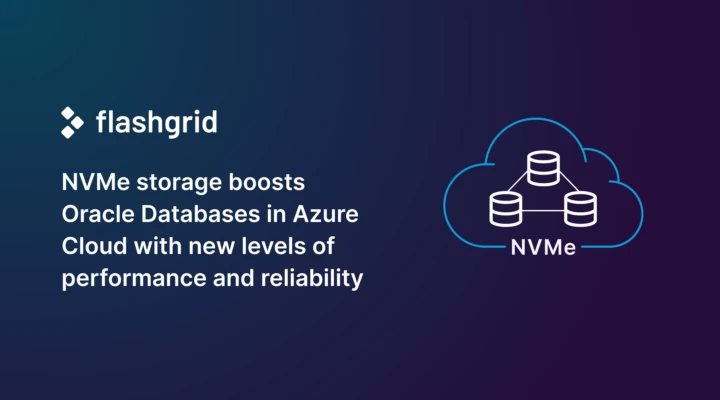Optimizing cost and performance of Oracle databases on Azure with the new Premium SSD v2 disks
June 6, 2023
Technical Series
Oracle databases are the core element of many mission-critical enterprise applications and running them in the cloud provides multiple benefits: agility, elasticity, and reliability. However, when it comes to architecting the database backend, there are often legitimate concerns about achieving the required levels of capacity, performance, and uptime within the budget constraints.
At FlashGrid, when we help customers deploy Oracle databases in Azure, we see the most success come from simple and inexpensive solutions. In this post, we will explore how the new Azure Premium SSD v2 disks enable high-performance Oracle databases with greater flexibility for managing performance and cost.
FlashGrid is an Azure ISV Partner who enables the running of clustered Oracle RAC databases on Azure. This includes multi-availability zone (AZ) capability, retaining full control of the database software, an infrastructure as code (IaC) deployment model, and 24/7 support.
How the new Premium SSD v2 can help you to reduce costs
Storage throughput of an Oracle Database on Azure VMs is determined by three factors:
- Throughput (MBPS and IOPS) per disk
- The number of disks per VM and per ASM disk group
- Total throughput cap imposed at the VM level
In the following examples, we assume you are using ASM disk groups to avoid the limited capacity and performance of a single disk.
It is preferable to utilize the full throughput capability of the VM. Otherwise, you incur the elevated cost of a larger VM while being bottlenecked by disk throughput – not the best use of your expensive Oracle licenses.
Now, let’s consider how you could configure your Azure disks to reach the 120,000 IOPS and 4,000 MBPS caps the largest VMs provide (e.g. Standard_E64bs_v5).
Each Premium SSD v2 disk can be configured with up to 64 TiBs of storage capacity, up to 80,000 IOPS and up to 1,200 MBPS throughput. Thus, four Premium SSD v2 disks let’s you reach the 4,000 MBPS cap for the largest VM sizes.
The most cost-efficient configuration of Premium SSD (a.k.a. v1) disks, that provides 4,000 MBPS, includes 27 P20 disks (27 x 512 GiB; 2,300 IOPS and 150 MBPS per disk). However, in most cases having 27 disks is not practical as the majority of VM types support up to 32 data disks.
In comparison, you only need two Premium SSD v2 disks to reach the 120,000 IOPS VM maximum. With Premium SSD (v1), you would have to use six disks to reach the same IOPS because Premium SSD (v1) has only up to 20,000 IOPS per disk.
We should also note that Premium SSD v2 disks, unlike Premium SSD (v1), allow you to configure the IOPS and MBPS independently of the disk capacity. With Premium SSD (v1), you may have to overprovision capacity (and pay for it) if you need higher IOPS, but not with Premium SSD v2.
These are our calculations of annual costs in the East US region for three different capacity/performance configurations:
| Ultra disk | Premium SSD (v1) | Premium SSD (v2) | |
|---|---|---|---|
| 10 TiB; 4,000 MBPS; 20K IOPS | $43,408 1 disk x 10TiB 20K IOPS, 4000 MBPS | $32,440 20 disks x 1TiB | $12,044 4 disks x 2.5TiB 5K IOPS, 1000 MBPS |
| 10 TiB; 4,000 MBPS; 120K IOPS | $102,976 1 disks x 10TiB 120K IOPS, 4000 MBPS | $49,736 16 disks x 2TiB | $18,176 4 disks x 2.5TiB 30K IOPS, 1000 MBPS |
| 100 TiB; 4,000 MBPS; 120K IOPS | $235,377 2 disks x 50TiB 60K IOPS, 2000 MBPS | $147,588 13 disks x 8TiB | $106,981 4 disks x 25TiB 30K IOPS, 1000 MBPS |
With Premium SSD (v1), you must overprovision capacity to achieve the desired IOPS / MBPS numbers. For example, in the first two configurations of 10 TiB with Premium SSD (v1), you would provision 20 TiB and 32 TiB of total capacity.
In all the examples above, Premium SSD v2 is between 1.3 to 6 times more economical than the corresponding Premium SSD (v1) configuration. Additionally, the number of Premium SSD v2 disks is kept to the minimum required to provide the desired IOPS / MBPS, whereas the Premium SSD configurations must have 2x to 5x more disks to achieve the same performance.
What about the Ultra disks?
You may ask, “Why not use Ultra disks that also allow me to configure the IOPS independently of the capacity?” So, we also included Ultra disks in our cost calculations.
You can see that although Ultra disk configurations allow you to use the minimum number of disks, they are usually 2x to 5x more expensive than similar Premium SSD (v1 or v2) configurations providing the same IOPS / MBPS. Like we mentioned before, Oracle ASM allows you to easily combine multiple disks per disk group and leverage their total throughput.
Bottom line: unless you can’t use ASM to combine the performance and capacity of multiple disks, there is no point in paying more to use Ultra disks.
Summary
In many cases, the performance of Oracle databases is determined by the performance of the underlying storage. With the new Premium SSD v2 disks, you can reach the highest throughput levels with a lower cost.
In conclusion, Premium SSD v2 disk configurations are less expensive than Premium SSD or Ultra disk configurations (up to 5.6 times in some cases) while providing the same level of performance without the need to overprovision for storage capacity.
Subscribe to our updates

Subscribe to our updates
External resources

Oracle databases, even RAC, are supported on AWS, Azure, and GCP

Considerations for migrating heavy IO workloads to Azure, including Oracle


















